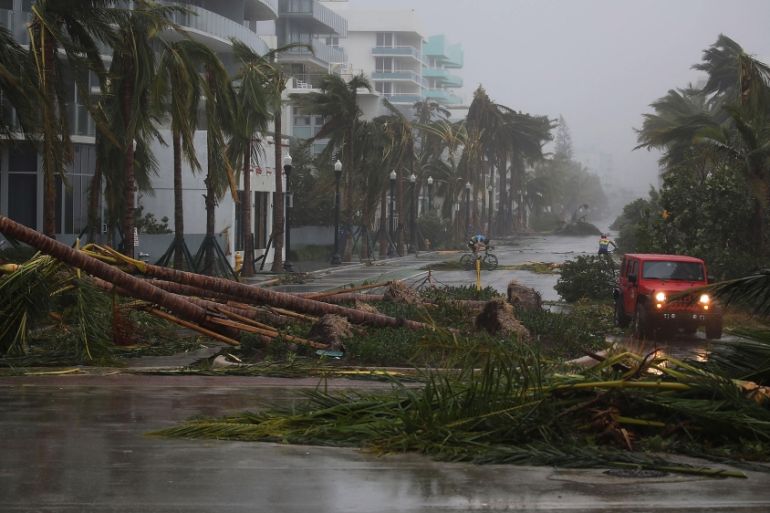Hurricane Irma gives Florida coast-to-coast pummelling
More than three million people are without power amid high winds and flooding, as fears grow over storm surges.

Hurricane Irma is giving Florida a coast-to-coast pummeling with winds up to 210km/h, swamping homes and boats, knocking out power to millions and toppling massive construction cranes.
|
|
The 640-kilometre-wide storm blew ashore Sunday morning in the mostly cleared-out Florida Keys as a Category 4 hurricane before eventually weakening to a Category 2 storm as it moved up the coast.
Keep reading
list of 4 itemsPhotos: Dubai reels from flood chaos as record rains lash UAE
Dubai submerged in floods as UAE gets over a year’s worth of rain in hours
Heavy rains kill 18 in Oman as flash floods lash UAE
Forecasters said it could hit the heavily populated Tampa-St Petersburg area early on Monday.
“Pray, pray for everybody in Florida,” Governor Rick Scott told US media on Sunday.
At least three people were reportedly killed in two separate vehicle accidents in Florida that took place as the stormed arrived. At least 25 people were killed during Irma’s destructive trek across the Caribbean earlier this week.
Storm surges
A storm surge of over three metres was recorded in the Florida Keys, and forecasters warned some places on the mainland could get up to 4.5 metres of water.
“This is a life-threatening situation,” Scott told a press conference.
Al Jazeera’s Kristen Saloomey, reporting from Naples in south Florida, said that while “the worst of the storm had passed over the city, the next big thing people were worrying about was the storm surge”.
She added that a surge of up to 4.5 metres could put the entire downtown area of Naples at risk.
Some 645km north of the Keys, people in the Tampa-St Petersburg area braced for the onslaught on Sunday night.
The Tampa Bay area, with a population of about three million, has not taken a direct hit from a major hurricane since 1921.
READ MORE: What you need to know about Hurricane Irma and its impact
Al Jazeera’s Heidi Zhou-Castro, reporting from Tampa, said those in the city are very concerned about storm surges as well.
“The real dangers here are three-fold,” she said.
“People are worried about the winds of 150km/h, which are predicted in Tampa, as well as the rainfall, and the highest concern is the storm surges.”
Entire state ‘at risk’
While Irma raked the state’s Gulf Coast, forecasters warned that the entire state – including the Miami metropolitan area of six million people – was in danger because of the sheer size of the storm.
In Miami, a woman who went into labour, was guided through delivery by phone when authorities could not reach her in high winds and street flooding. Firefighters later took her to the hospital.
Two of the two dozen construction cranes looming over the city’s skyline collapsed in the wind. No injuries were reported. City officials said it would have taken about two weeks to move the massive equipment.
![More than three million customers have lost power in southern Florida [Carlos Barria/Reuters]](/wp-content/uploads/2017/09/cf0a63d8516e449bbaae6037e38675aa_18.jpeg)
Al Jazeera’s Alan Fisher, reporting from Miami, said there was a point during the afternoon on Sunday that the rain and wind were so strong that visibility was reduced to less than 10 metres.
“It was so heavy that you really couldn’t see much further than your hand,” Fisher said.
“The good news is that many people have moved out of their homes, they have gone to the shelters that have been provided – more than 375 of them across the state – and they will stay there, probably until Tuesday or Wednesday when the water starts to recede and things get back to normal.”
Power outages
Curfews were imposed in Miami, Tampa, Fort Lauderdale and much of the rest of south Florida, and some arrests of violators were reported.
|
|
Florida Power & Light said that more than three million customers were without power by Sunday evening and more outages were expected as the storm moved further north.
The utility company added that full restoration of service could take weeks.
Nearly seven million people in the southeastern part of the US were warned to evacuate, including 6.4 million in Florida alone.
After leaving Florida, a weakened Irma is expected to push into Georgia, Alabama, Mississippi, Tennessee and beyond. A tropical storm warning was issued for the first time ever in Atlanta, Georgia, which is some 320km from the sea.
President Donald Trump approved a disaster declaration for Florida, opening the way for federal aid.
Florida’s governor also activated all 7,000 members of the Florida National Guard, and 10,000 guardsmen from elsewhere were being deployed.
Irma at one time was the most powerful hurricane ever recorded in the open Atlantic, a Category 5 with a peak wind speed of 300km/h, and its approach set off alarms in Florida.
READ MORE: Irma causes devastation across the Caribbean
For days, forecasters had warned that Irma was taking dead aim at the Miami area and the rest of the state’s Atlantic coast.
But then Irma made a more pronounced westward shift that put a bull’s-eye on the Tampa area – the result of what meteorologists said was an atmospheric tug-of-war between weather systems that nudged Irma and determined when it made its crucial right turn into Florida.
Before making its way to Florida, Irma blasted the Caribbean, ripping roofs off houses, collapsing buildings and flooding hundreds of kilometres of Cuba’s coastline after it had already devastated several other islands in the Caribbean.
|
|